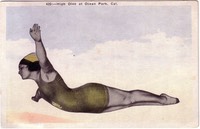Terrell C. Drinkwater History of the Los Angeles Country Club 1898-1973, Unknown publisher, 1973, 127 pp., 1898, 1897, 1890s,1927, 1946,
Since golf courses could be prepared in three to five days, they were springing up all over
Southern California in 1898 and 1899: two at Riverside, Rubidoux and Riverside Golf and Polo club; two at Pasadena, the Hotel Green course and Pasadena Country Club; at Redondo Beach; the Pachappa Links in Arlington, Riverside County; a second course, Ocean Park, at Santa Monica; Hemet; two courses at Redlands, La Casa Loma and Redlands Country Club; the Country Club of Santa Barbara.
They were sprouting too in Northern California: Del Monte on the Monterey Peninsual; Burlingame, San Rafael, Oakland.
. . . [photos]
. . .
An editorial, Golf, Los Angeles Morning Herald, April 17, 1899 . . . the Los Angeles Country Club has enlarged its membership to 400 . . .
[p. 30]
[p. 43] . . .
Because the new clubs were having so many invitational tournaments, a uniform golfing organization in Southern California was urged. Tufts and Sartori were the leaders in bringing this over-all group—the Southern Californis Golf Association—into being.
On July 29, 1899, at the invitation of “Uncle Ed” and “Mr. [p. 44] Sartori . .
Clubs forming the SCGA and golfers present at the initial meeting were: The Los Angeles Country Club, Sartori and Tufts; Pasadena Country Club, J.B. Miller; Riverside Polo and Golf Club, C.E. Maud and R.D. Osburne; Santa Monicsa Golf Club, M.G. Burmeister; Redlands Golf club, A.E. Sterling.
SCGA’s first officers were: Maud, president; Sartori, secretary; vice presidents, J.B. Miller and A.S. Auchencloss, Redlands; treasurer, Roy Jones, Santa Monica. The executive committee was to consist of Maud, Sartori, Miller, Tufts, and Osburne. A year later, Tufts was named “Official Handicapper,” a post he held from 1900 to 1927. Sartori was SCGA president in 1903 and 1904. Tufts becane president in 1912 and served until his death in 1927.
. . .
[p.46] Play commenced on the Club’s Pico at Western course on November 4, 1899, and it was one of the top social events of Los An- [p. 47] geles that year. Crowded trolleys, smartly drawn surreys snd Victorias and tinkling-belled bicycles converged on the new and handsome clubhouse. Bruce Jones, a black man who was to become one of the Club’s storied characters, was waiting at the end of the streetcar line with his one horse wagon to transport members the half mile or so over unpaved Pico to the Club grounds. Six persons, eight if they jammed together, could ride in Bruce’s rig. The rides cost five cents each and passengers usually matched nickels all the way to the clubhouse to see who paid the bill.
On opening day the Pico-Western clubhouse was fesatoonedd with colored streamers and on a corner of the frontg vernanda an orchestra played popular tune of the day: “Little Annie Rooney,” “Sweet Marie,” “There’ll Be a Hot Time in The Old Town Tonigh” as well as old favorites such as “The Blue Danube.”
Silk petticoats rustled, tweeds mingled with tulle, bright colored golfing jackets reappeared and some of the men players who competed in the day’s golf tournament even wore ties.
. . .
